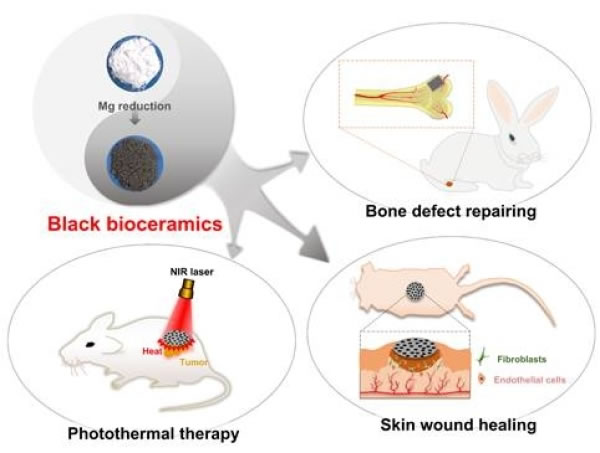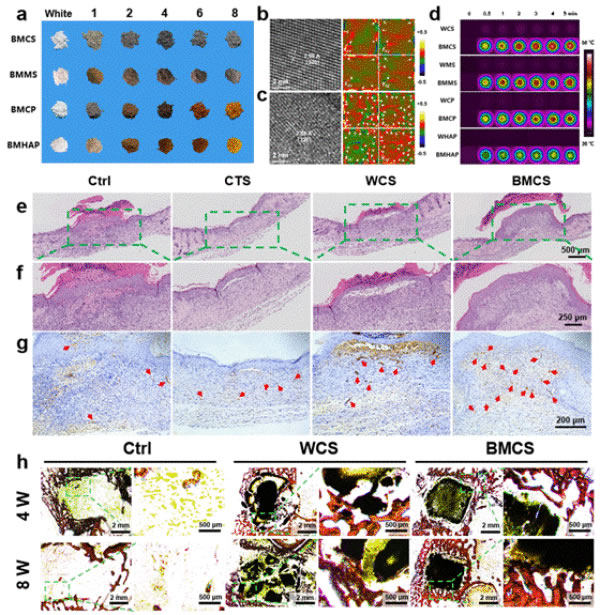Bioceramic materials have a long history of being used to repair human hard tissues, from biologically inert materials (such as alumina and zirconia, etc.) to biological materials that are both bioactive and degradable (such as phosphate and silicate bioceramics, silicon Based bio-glass, etc.), its physiological function is no longer a simple tissue filling substitute, but a tissue engineering material that can induce tissue regeneration, regulate cell growth and functional differentiation. More and more evidences show that specific bioactive ceramic materials have the effect of promoting the specific cell regeneration activity of soft/hard tissues, and are widely used in the repair of tissue defects in bones, teeth and skin. However, there are many special tissue damages in clinical practice, such as tissue defects after surgical resection of bone tumors or skin cancer tissues. It is necessary to remove the remaining tumor cells before repairing the tissue defects to avoid tumor recurrence. In order to achieve the dual functions of tumor treatment and tissue regeneration, the previous research prepared photothermal functionalized bioactive ceramic materials by compounding bioactive ceramics with photothermal reagents with tumor treatment functions. Although this is an effective strategy, the long-term safety of photothermal nanoreagents in vivo remains to be investigated. Therefore, how to realize the integration of tissue regeneration and tumor treatment functions of the bioactive ceramic material itself without introducing foreign additives is particularly important. Recently, the research team led by Wu Chengtie and Chang Jiang, a researcher at the Shanghai Institute of Ceramics, Chinese Academy of Sciences, has made progress in the research of multifunctional black bioactive ceramic materials. The research team developed a new generation of "black bioactive ceramics" by thermally reducing traditional white bioactive ceramic materials (silicate and phosphate, etc.), expanding the application fields of traditional bioactive ceramic materials from tissue regeneration To the treatment of tumors and other diseases. Related research results were published on Advanced Materials (Adv. Mater., 2020, 2005140) with the title Black Bioceramics: Combining Regeneration with Therapy, and applied for a patent. The first author of the thesis is Wang Xiaocheng, a Ph.D. graduated from Shanghai Institute of Ceramics, and the instructor is researcher Wu Chengtie. The team used the magnesium thermal reduction method to thermally reduce the traditional white bioactive ceramic powder to prepare a series of black bioactive ceramic materials, including silicate (ie CaSiO3, MgSiO3) and phosphate (ie Ca3(PO4)) 2. Ca5(PO4)3(OH)) bioactive ceramics in two systems. Compared with traditional white bioceramics, there are a large number of oxygen vacancies and structural defects in the crystals of black bioceramics, and its degradation performance has been significantly improved. It is effective for the adhesion, spreading, proliferation, migration and differentiation of osteoblasts and skin cells. Cell biological activity has a better promotion effect. In animal experiments on the repair of chronic skin trauma and large bone defects, black bioceramics have a significantly better repair effect on skin and bone tissue than white ceramics, and show significant activity in promoting multifunctional regeneration of soft/hard tissues. In addition, under low-power near-infrared light irradiation, the black bioactive ceramic material exhibits a significant photothermal heating effect, which can lead to the death of tumor cells around the material, and successfully inhibit the growth of skin cancer and bone tumors in in vivo experiments. Excellent photothermal anti-tumor effect. In summary, the black bioactive ceramic material has the multi-functional properties of promoting a variety of tissue regeneration activities and tumor treatment. This research expands the application range of bioactive ceramics from tissue regeneration to tumor treatment, and strongly promotes the development of bioceramics. And clinical applications. The research work is supported by the National Key Research and Development Program, the National Natural Science Foundation of China, and the Shanghai Municipal Science and Technology Commission. (A) Black bioactive ceramic powder with adjustable appearance and color; white calcium silicate (b, WCS) and black calcium silicate ceramic powder (c, BMCS) high-resolution transmission electron microscope photos and geometric phase analysis show that BMCS crystal The internal lattice distortion is serious and there are a lot of structural defects; (d) Under near infrared light and heat irradiation, the black bioceramic material has a significant heating effect; compared with the white calcium silicate ceramic group, the black calcium silicate ceramic material group has The healing speed and quality of chronic skin wounds are significantly improved (ef), and it shows better activity in inducing bone tissue regeneration in the repair of rabbit femoral defects in vivo (h) SUN YAT INDUSTRY LIMITED , https://www.ernte-eu.com
Preparation of black bioactive ceramic material and its application in the fields of bone/skin tissue regeneration and tumor treatment